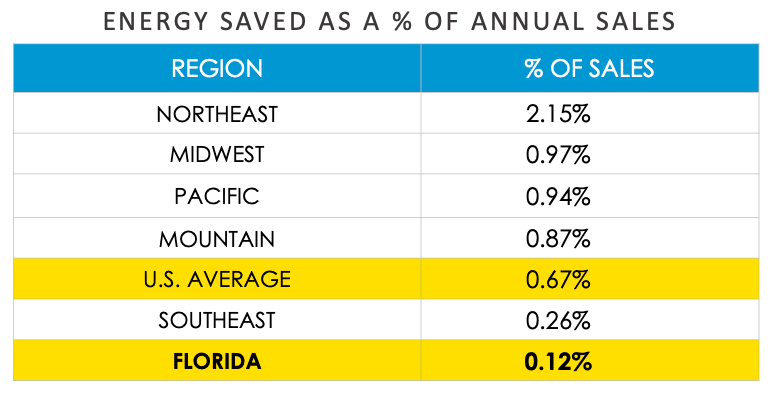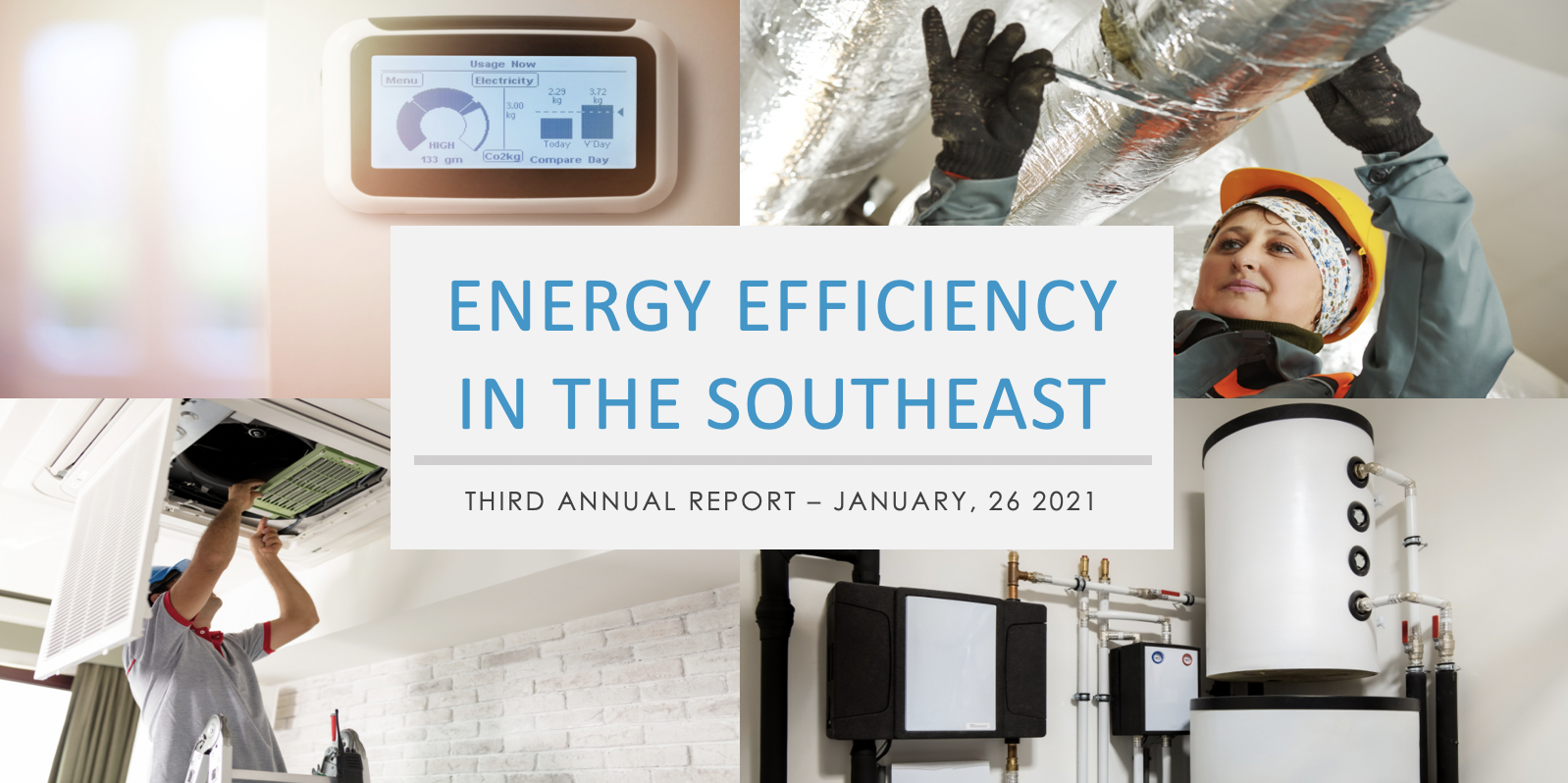This is the sixth in a series of blogs tied to SACE’s third annual “Energy Efficiency in the Southeast” report. Each year SACE compiles efficiency performance data from nearly 500 electric utilities in the Southeast. The first five blogs in this series featured publication of this year’s efficiency report; Duke Energy’s performance and ways it can still strive for higher savings; pressures on Dominion Energy to increase efficiency in its integrated resource plan; and TVA’s decision to largely abandon its efficiency programs altogether. We now turn to one of the most important policy developments in the Southeast today: the effort to reform of Florida’s seriously outdated energy efficiency rules.
[button color=”blue” url=”https://bit.ly/seeereport21″]Download the Report[/button]
[button color=”blue” url=”https://cleanenergy.org/?s=SEEnergyEfficiencyReport2021″]Read the Report Series[/button]
[button color=”blue” url=”https://cleanenergy.org/news-and-resources/energy-efficiency-in-the-southeast-third-annual-report-webinar/”]Watch the report webinar[/button]
Florida Missing Out On The Benefits of Efficiency
States in the Southeast, including Florida, continue to underperform on energy efficiency compared to other regions and the country as a whole. For example, the Southeast had average energy saved as a percentage of annual sales of 0.26% in 2019. But utilities in the Midwest averaged 0.97% and savings in New England were 2.15% – almost ten times higher than the Southeast. Meanwhile, average savings for the whole country was 0.67%, five times higher than Florida’s 0.12%, which is among the worst in the nation. The American Council for an Energy Efficient Economy (ACEEE) ranks Florida 46th in its State Scorecard for annual utility efficiency program savings.

By underinvesting in energy efficiency, utilities are forcing millions of Florida customers to pay unnecessarily higher costs for energy that is simply being wasted. This in turn leads to the construction of more expensive fossil fuel power plants, which boost utility profits while driving customer bills up even further.
Because Florida is the most populous state in the Southeast (and third in the nation), its low efficiency has an outsized effect on the performance of the region as a whole.
Groundswell of Local Voices for Higher Efficiency, Rules Reform
Florida’s low efficiency performance is concerning to both citizens and local governments. Not only do they shoulder the added cost of persistent energy waste, but they also recognize that energy efficiency is critical to reducing harmful carbon emissions and transition to clean energy. During the most recent Florida Energy Efficiency and Conservation Act (FEECA) goal-setting proceeding, a record number of pubic comments were submitted to the Public Service Commission (PSC) –over 5,000 in total– calling for higher efficiency goals for the state’s largest utilities. The Commission ultimately rejected the utilities’ proposed goals (many of which sought to have no savings goals at all) and called for reform to the FEECA rules. These rules have not been updated in nearly three decades.

Now that FEECA rulemaking is underway, momentum is building once again to ensure reforms are made to the most flawed aspects of the rule, which could allow Florida to finally attain efficiency savings that are more in line with the rest of the country. In just the past few months, customers have submitted more than 6,000 total comments into the FEECA proceeding asking the Commission to reform its outdated efficiency practices.
Local governments are also making their voices heard. During the 2019 goal-setting proceeding, a dozen local governments passed resolutions calling for the Florida PSC to approve higher efficiency savings. Since the start of the FEECA rulemaking, the City of Miami Beach, City of Largo, Orange County, City of St. Petersburg, City of Tarpon Springs, and Broward County have already taken action. They are calling for the elimination of flawed economic analysis screens and greater emphasis on energy efficiency programs for low-income customers. The Southeast Florida Climate Compact, whose members represent 6 million residents, has also weighed in with its support for FEECA reform.
Efficiency Key to Energy Affordability and Attaining Clean Energy Goals
Each of the local governments who have written to the PSC have emphasized common themes while noting the unique steps they are taking to reduce greenhouse gas emissions and help their communities manage energy costs.
The City of Tarpon Springs states, “We recommend that a primary goal of this review be to increase the requirements for Florida electric utilities to provide energy efficiency programs and access to those programs to all customers, with particular consideration for low-income customers…Offering programs to address the needs of low-income families is more important than ever given the continuing economic fallout from the COVID-19 crisis. The thousands of families that are in arrears on bills or have been disconnected lays bare the fact that at so many have unnecessarily high bills in the first place.”
Orange County plans “to achieve 100% of County operations electricity load from clean, renewable sources by 2035.” Its letter requests “that the PSC enhance efforts by utility providers throughout the State of Florida to increase their energy efficiency goals, programs, and policies.”
Broward County is pursuing greenhouse gas emissions reductions of 80% by 2050 and its resolution “urges the PSC to expand the scope of the current FEECA rulemaking to provide for adoption of national best practices that modernize how energy conservation goals for utilities are set in Florida.”
Local Governments Can Do Their Part, But More Is Needed from Utilities
Local commitments and actions are vital for cities to achieve their energy affordability and clean energy goals. But these efforts must be matched with expanded utility efficiency investments, supported by sound FEECA policies.
The City of St. Petersburg is pursuing 100% renewable energy by 2035 and an 80% reduction of its greenhouse gas emissions by 2050 and notes, “Programs managed by Duke and TECO to support efficiency upgrades would allow us to implement more work at our facilities as incentives would reduce the project costs, thereby allowing the city to fund more projects and operate more efficiently in terms of both costs and environmental impacts…Utilities are particularly well suited to support energy efficiency efforts and should have specific goals and programs in place to increase the efficient use of electricity in the state.”
The City of Largo “is committed to transitioning the organization to 100 percent renewable energy by 2035 and for the community by 2050.” Its letter notes that “Energy efficiency is a critical tool to help us achieve all of these outcomes. Despite robust efforts, local governments like ours are often constrained in how much we can do to drive down our total greenhouse gas (GHG) emissions…Therefore, we have a significant interest in finding ways to systematically improve the emissions performance of our electricity system, including through the support of policies and programs that eliminate energy waste and reduce peak demand.”
Many more local governments are concerned about the high cost of energy, both for their citizens and their own operations. And others have made similar commitments to reduce carbon emissions or transition to renewable energy. Their success ultimately hinges on reform of the PSC’s FEECA rules and increased utility investment in energy efficiency.
The voices of thousands of customers, along with local governments representing millions more, should be given considerable weight as the PSC considers what changes to make to its energy efficiency policies and practices.
Fixing FEECA’s Fundamental Flaws Key to Increased Efficiency
During the first FEECA rulemaking workshop held on January 14, SACE was joined by dozens of compelling speakers, including business owners, homeowners, low-income and elderly advocates, municipal leaders, and sustainability organizations, who shared their perspective on the rule changes needed. The meeting lasted for over three hours, and included oral statements and written comments that argued clearly for three essential changes that must be made in the revised FEECA rules:
- Replacement of the flawed RIM test with modern economic cost-effectiveness analysis tools;
- Elimination of the two-year payback screen, which undermines the most effective efficiency improvements; and
- Establish clear guidelines to ensure the needs of low-income customers are prioritized in program design, savings targets, and budgets.
Florida’s low efficiency performance is directly attributable to these shortcomings. As noted in SACE’s testimony during the 2019 FEECA goal-setting proceeding, a virtually imperceptible rate impact of just a fraction of one percent can ultimately yield more than $100 million worth of utility system benefits. That means total costs to customers would be reduced by over $100 million if the Commission revises its FEECA rules to include modern cost-effectiveness methods. Likewise, eliminating the two-year payback screen would have a huge effect, with savings roughly doubling – or more – if this flawed restriction is removed.
The message is clear, FEECA reform must address the substantive issues that have long undermined efficiency savings in Florida.
Why Both Florida’s Best and Worst Performing Utilities Must Do More
There is wide variation between Florida’s major utilities on energy efficiency goals and performance, which itself speaks to the need for clearer expectations in the FEECA rules. For instance, Tampa Electric’s 0.44% annual efficiency savings in 2019 was ten times higher than Gulf Power’s 0.04%, and Florida Power & Light was only a fraction higher at 0.05%.

Even Florida’s top-performing companies still trail far behind their utility peers across the country. ACEEE’s 2020 Utility Scorecard ranked the efficiency performance of the nation’s largest utilities. TECO, Duke Energy Florida, and Florida Power & Light were 44th, 46th, 50th, respectively, out of 52 for net efficiency savings. All were far below the average annual savings for large utilities in ACEEE’s study, which was 1.03%.
What Happens Next?
The changes called for in this rulemaking are extensive and substantive. But to date, Commission Staff have made only cursory tweaks that fail to address the root problems causing Florida’s low efficiency performance. The next step in this rulemaking needs to be a second public workshop to discuss the substantive issues in FEECA, followed by corresponding changes to the rules for Commission consideration. Many have requested the second workshop, but to date, nothing has been scheduled.
No matter how you look at it, improving Florida’s energy efficiency rules would make a big difference for customers, the state, and the Southeast. When thousands of voices call for change, the message simply cannot be ignored.
To submit a comment to the Florida Public Service Commission regarding the FEECA rules, and to learn more about energy efficiency in Florida, click here:
[button color=”green” url=”https://energysmartfl.com/”]Take Action[/button]
Find out more from our Third Annual “Energy Efficiency in the Southeast” Report and blog series below:
[button color=”blue” url=”https://bit.ly/seeereport21″]Download the Report[/button]
[button color=”blue” url=”https://cleanenergy.org/?s=SEEnergyEfficiencyReport2021″]Read the Report Series[/button]
[button color=”blue” url=”https://cleanenergy.org/news-and-resources/energy-efficiency-in-the-southeast-third-annual-report-webinar/”]Watch the report webinar[/button]
#SEEnergyEfficiencyReport2021



